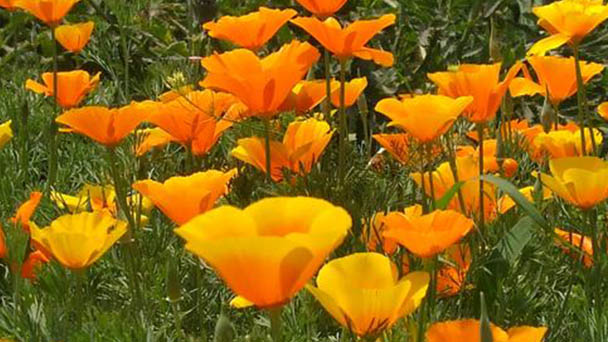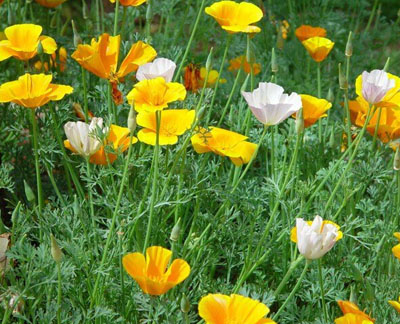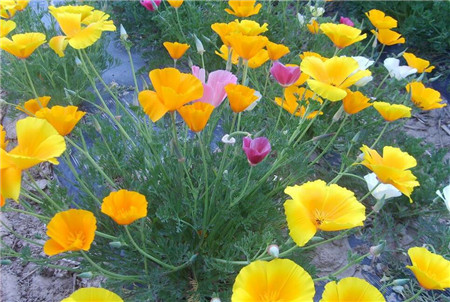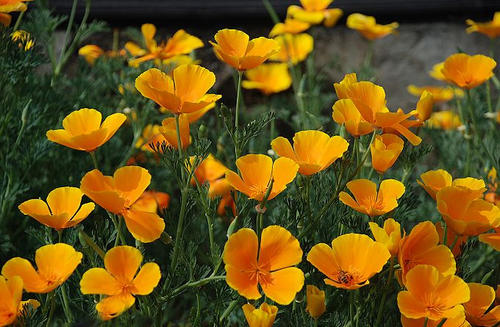California poppy (Eschscholzia californica) profile
Written by Maggie
Mar 11 2021

California poppy (Eschscholzia californica) , also called golden poppy, California sunlight or cup of gold, is a perennial herb. It is often cultivated for a year or two. California poppy has strong cold resistance, like cold and dry climate, can not resist hot and humid, hot summer in a semi-dormant state, often die, and then germination after autumn.Originating in California, USA.
California Poppy has bright green-tinged leaves and stems with bright colors, making it a good source for ribbons, flowertracks, and potting plants. It can also be used in lawns.
California Poppy is originally from the state of California. More cold, like cold and dry climate, not easy to hot and humid, should be loose and fertile, well drained, deep upper sandy loam, also poor soil resistance. Perennial herbaceous flowers are often cultivated as a biennial.
California poppy is the state flower of California, also known as the California poppy, ginseng flower, golden flower.
Most wild California poppies have pale yellow, orange, or cream flowers. When you face the California Poppy in the almost boundless wilderness, you can't help admiring it, and you will feel a beautiful poetic feeling in your heart.
California Poppy has bright green stems and leaves, tinged with gray, and is very attractive in its bright colors. At the turn of spring and summer, California poppies are often seen on front lawns. They are also planted into flower diameter flower belts, so that the house adds a full of vitality.
California poppy picture

California poppy info
| Botanical Name | Eschscholzia californica |
| Common Names | California poppy,golden poppy, California sunlight or cup of gold |
| Plant Type | Tender perennial |
| Sun | Full sun |
| Hardiness Zones | USDA growing zones 8-10 as a perennial; annual everywhere |
| Flower color | Orange, yellow, pink, white |
| Native Area | Western United States |
| Mature size | 12 inches |
Morphological characteristics of California poppy
California poppy is a perennial, glabrous, bluish-gray plant.
Stem of California poppy is erect, 30-60 cm high, clearly with longitudinal ribbed, branching many, open, dichaform. Basal leaves are several, 10~30 cm long, petiole long, leaf gray green, many back to three pinnately fine lobes, lobes variable shape, linear acute, oblong acute or blunt, spatulate oblong, terminal 3 lobes, middle lobes mostly wider and shorter; Cauline leaves the same as basal leaves, but smaller and shortly stipitate.
Leaves of California poppy are alternate, many back to three out pinnate split, split linear or elliptic, the whole blade has a long stalk. Flowers are solitary branch apex, ca. 5-7 cm in diameter, long pedicels.
Receptacle raised, sepals 2, joined into a pointed long galea, falling off with petals spread; California poppy has 4 petals, easy to fall off, cross opposite, fan-shaped, margin fine undulate, bright yellow, the base of deep orange yellow, shiny. Cultivated varieties are orange yellow, golden yellow, orange red, light purple red, flesh color, milky white. Petals are often wrinkled and there are double varieties.
Flowers of California poppy are solitary at apex of stems and branches; Pedicels are 5 -- 15 cm long, receptacle concave, funnelform or sub tubular, 3 -- 4 mm long, cup-shaped after flowering, margin undulate reflexed; Calyx is ovate-shaped, ca. 1 cm long, tip short paniculate, sepals 2, glabrescent; California poppy has 4 petals, triangular-flanellate, 2.5 -- 3 cm long, yellow, with orange-yellow spots at base; California poppy has many stamens, about 40 more, filaments filiform, base broadened, about 3 mm long, anthers strip, 5~6 mm long, orange yellow; Ovary is long and narrow, style short, stigma 4, subulate linear, unequal in length.
Capsule of California poppy is narrow cylindrical, 5-8 cm long, detached from receptacle, 2 petals descending from base upward, with many seeds. The fruit is an arrowed capsule, 7 to 10 cm long and slender, resembling a rape pod. Seeds are globose or slightly elliptic.The flowers of the same genus as this species are caespitose California poppy and curving California poppy.
Seeds are globose, 1-1.5 mm in diameter, distinctly reticulated.
The ecological habits of California poppy
California Poppy grows in grassy and open areas from zero to 2,000 meters above sea level.
More cold, like cold and dry climate, not easy to hot and humid, should be loose and fertile, well drained, deep upper sandy loam, also poor soil resistance.
California poppy has strong cold resistance, likes cold and dry climate, and can not withstand heat and humidity. It is in a semi-dormant state in hot summer, and often dies, and then germinates after autumn. California poppy belongs to a fleshy straight root system, must be deep loose soil, requires good drainage, large seedlings should not be transplanted. It can sow and reproduce itself.
How to grow and care for California poppy
(1) California poppy root meat, like monotonous, afraid of waterlogging. In the rainy season, the ground should pay attention to timely drainage, potted plants should be watered in appropriate amounts, should not be wet and dry, to avoid the root neck black erosion.
(2) Because California poppy is a kind of plant with long taproots, it is not resistant to transplantation, so it is better to seed seeds in pots.
(3) California poppy sown in spring and flower in summer, but usually grow and flower less well than those sown in autumn. Therefore, sowing should be carried out in summer, and the suitable temperature for germination is 15-20 ℃. If the germination is not neat, more dense seedlings, appropriate thinning. Planting spacing 20-30 cm, planting to high dry, drainage is better. Growing period should pay attention to soil weeding, open winter should take cold prevention measures.
(4) After the skin turns yellow, the fruit should be harvested in time in the early morning, otherwise the capsule will crack automatically, leading to seed scattering.
Fall care
Seedling of California poppy on the pot after a period of time to recover, the fertilizer and water management to quickly catch up. The fertilizer and water management follows the sequential cycle of "Huabao" -- "Huabao" -- "Huabao" -- "Huabao" -- "Huabao" -- "Qingshui", and the interval period is about 1-3 days. In winter and spring, the interval period is shorter during sunny days or high temperatures, and longer during cloudy and rainy days or low temperatures or no watering.
Winter care
Although California poppy still continues to grow, the lower temperature will slow its growth rate, and it does not require much fertilizer and water, or even control fertilizer and water. Fertilization and water management follows the sequential cycle of "Huabao" -- clear water -- clear water -- "Huabao" -- clear water -- clear water, with an interval of about 4~7 days. The watering time should be arranged as far as possible on sunny days when the temperature is high at noon.
In the spring
After the temperature rises, the California poppy growth recovers rapidly, and gradually enters the stage of flower bud differentiation and flowering, which requires a lot of fertilizer and water. Fertilizer and water management follows the sequential cycle of "Huabao" -- "Huabao" -- "Huabao" -- "Qingshui", and the interval period is about 2~4 days. The interval period is shorter during sunny days or high temperatures, and longer during cloudy days or low temperatures or no watering.After entering the fruiting period, stop the fertilizer supply.
Trim
In the process of California poppy flowering, cutting off three leaves of the remnant flower band, can prolong the flowering period.
Water care
With other brews, California poppy water demand is more, but the most afraid of chaos fertilization, concentrated fertilizer and n, p, k, required to follow the "light weight more frequently, and less time and complete nutrition" and "room of dry wet, dry to dry, not stem not watering, watering is drenched the" principles of two fertilization (water), and after fertilization, the evening want to keep the dry leaves and flowers.
Light
California poppies require a day of full daylight to bloom and hold plant vigor. Six hours of unfiltered daylight is imperative for poppy growth, and extra is even better. California poppies that develop in shady spots will appear ratty and succumb to fungal diseases.
Soil
The capability of California poppies to develop in areas with negative soil offers them an aspect of survival: whereas different plant life that wants wealthy loamy soil full of vitamins may flounder in depleted soils, California poppies go in to fill this niche. Sandy soils and rocky soils each furnish correct stipulations for California poppies. What would not work is heavy clay soils. California poppies want gorgeous drainage for their faucet roots, so if your soil is clay, attempt raised beds or container culture.
Temperature and humidity
The warming of the soil in the spring, mixed with moisture from spring rains, will set off germination of California poppy seeds. As lengthy as temperatures stay mild, between 50 and seventy five ranges F, California poppies will proceed to grow. In areas with warm summers, California poppy plant life will turn out to be dormant. However, when cool fall temperatures return, flora will regrow and re-bloom from their faucet roots.
Fertilizer
No fertilizer is quintessential to effectively develop California poppies, even in areas with bad soil. The addition of chemical fertilizers will purpose extra foliage boom at the rate of blooms.

Varieties of California poppy
'California Golden' provides that basic shiny orange shade the early settlers admired lots of years ago. 'Mission Bells' is a scrumptious combination of sherbet colours such as pink, salmon, and cream with some semi-double blooms. 'Golden West' is twisted on the acquainted orange bloom, as it points to a darker eye.
Growing California poppy in containers
The trick to developing California poppies in containers is to develop them from seed. With their lengthy faucet roots, the flora resent being transplanted. Treat container-grown poppies as a hardy annual, and pull them when they're finished blooming, as they are not going to remain over the iciness in a container.
Growing California poppy from seeds
Sow California poppy seeds the place you intend to develop them outdoors, after the final threat of frost. Press the seeds gently into the soil, watering gently to keep away from dislodging the tiny seeds. Germination takes place in about two weeks. You can distinguish germinating poppy seeds from weeds with the aid of gazing the bluish-green tint of poppy foliage. Thin seedlings to about eight inches apart.
How California poppy propagates
Seed propagation
With sowing method propagation, winter soil does not freeze regional line autumn sowing.In northern areas, seedlings are raised indoors in early spring and emerge in about 7 days under the condition of 15-20 ℃. In the true leaves to develop in time before the seedling on the pot, no frost, take off the pot with soil planting (do not hurt the root, otherwise it is not easy to restore growth. Even death); You can also open the ground before it freezes. With wind barrier protection, the seedlings were unearthed the next year. The California poppy seedling stage should be supplied with sufficient water and nutrients.
Cutting propagation
California Poppy cutting substrate: is used for cutting nutrient soil or river sand, clay soil and other materials. Family cuttings limited to the condition is difficult to get the ideal cuttings matrix, the use of this site has been prepared and disinfected cuttings matrix; Medium-coarse river sand is fine, but rinse with clean water several times before use.Sea sand and saline areas of river sand do not use, they are not suitable for the growth of flowers and plants.
The choice of cuttings: used for cuttings called cuttings.Usually combined with heart work, pick down the sturdy, no pests and diseases of the top as cuttings, directly with the top cutting.
Disease control for California poppy
California Poppy is not continuous cropping. In high temperature, high humidity conditions, or too much fertilization, can lead to the occurrence of pests and diseases.
Discover the disease, in addition to timely drug prevention and treatment, but also will be pulled out of the disease plant to burn or deep buried treatment.
Pay attention to field hygiene at the same time.
The distribution of California poppy
California Poppy is originally from the state of California. It is widely introduced as a garden ornamental plant in China.
Uses of California poppy
Ornamental value
California Poppy has beautiful leaves and bright colors.
California Poppy landscaping purposes
California Poppy has bright green-tinged leaves and stems with bright colors, making it a good source for ribbons, flowertracks, and potting plants. It can also be used in lawns.
Medicinal value
The sedative and antianxiety effects of extracts of California Poppy may be related to the activation of benzodiazepine receptors. However, unlike these drugs, the extracts have no anticonvulsant and muscle relaxation effects, and the analgesic effects of extracts are peripheral rather than central.
California poppy toxicity
California poppy has certain toxicity, direct contact with its leaves may feel skin itching, particles, and you must see a doctor; Eating the fruit may cause vomiting, diarrhea and other symptoms.

Latest Updated
- Benefits of Bugleweed - 7 Science-backed Health Benefits
- Bugleweed Dangers & Side Effects - Is It Poisonous?
- How to Plant Evergreen Trees - What You Should Know
- When to Plant Evergreens - Grow Guide for Evergreen Trees
- 12 Wonderful Evergreen Shrubs for Your Garden
- 12 Popular Evergreen Plants with Pictures for Beginners
- When And How To Prune A Lilac Bush Like a Pro
- How to Grow & Care for Lilac Vine (Hardenbergia Violacea)
- Japanese Lilac Tree (Syringa Reticulata) Care & Propagation Guide
- Shumard Oak Pros and Cons - What to Know
Popular Articles
- Winter maintenance of Antirrhinum Majus
- How to Grow Terminalia Mantaly Tree
- How to Grow and Care for Crossostephium Chinense
- How to grow Antirrhinum Majus in spring
- Peristeria Elata (Dove Orchid) Profile: Info & Care Guide
- Underwatered Snake Plant (Sansevieria Trifasciata) - Signs And How To Fix
- How to Care for Brazilian Jasmine Plant (Mandevilla Sanderi)
- How to Grow & Care for Graptopetalum Purple Delight in Summer
- Rosa Chinensis (China Rose): Plant Growing & Care Tips
- How to Care for Baby Sun Rose (Aptenia Cordifolia)